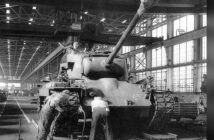Up until the year 1840, Genesee County had a self-sufficient economy through successful agricultural production, fishing, hunting, and farm and forest work. Agriculture was the main occupation in 1840 with 3,300 residents registered in this line of work out of 4,269 total residents. It is not surprising that most of the workers were in manufacturing, trade, commerce, and learned professions, and that these residents were living along both sides of the old Saginaw Trail for optimal trade opportunity. At this time, agriculture was still the county’s most common occupation, with 4,501 farms producing $5,198,827 worth of goods.
The 1840s began a rise in retail jobs and various types of mills that began employing more people. There were three flour mills and ten sawmills, employing 27 men. But, despite the growing population and popularity of other industries, agriculture remained the top profession up until the 1900s. The agricultural economy benefitted the lumbering industry through its production of hay, bringing a considerable amount of revenue to the lumbermen.
From 1855-1880, Flint became a thriving lumber town. Around 1870, Flint reached its lumbering peak; the population reached 5,000 and the city had 18 lumber dealers, 11 sawmills, three flour mills, and various other mills and factories. At its peak, the lumber industry annually made more than $1 million for Flint alone. Because of the growing industry, these lumberman needed transportation, thus oxcarts began carrying logs from the forest to the towns that needed them. Farmers needed wagons, and shopkeepers needed other horse-drawn vehicles to travel around town. Eventually, railroads were also needed to transport goods farther away.
In 1862, the Flint-Holly railway was opened, which linked Flint to a major rail network, along with the Flint and Père Marquette railways, which connected Flint to Saginaw for trade. This did give the economy an immediate boost, however short-lived, because the Civil War increased the demand for lumber. And as the lumbermen consumed the natural materials for their industry, farming continued to increase, because residents, anxious about the growing population, were anticipating economic decline. The occupation of farming continued to grow as the population grew. This was a result of the lumber industry dying off, and there ended up being more farmland than ever before.
In 1850, the most common occupation among foreign-born residents was farming, followed by laborer, shoemaker, mechanic, and cabinetmaker (see sidebar). Compared to a decade later, carpentry and serving took the place of mechanic and cabinet maker. By 1900, farming was still the most common occupation, followed by blacksmith and carpenter.
By the 1870s, residents cultivated the lumber business, and further enhanced the economy with woolen manufacturing, textiles, cigar making, and carriage and furniture production. Most residents were somehow involved in lumbering. All of these trades made possible the absorption of the growing population in the 1870s.
The years between 1869 and 1871 were the highpoints of prosperity for lumbering, with nine mills in operation, employing over 500 men, and an annual capacity of ninety million feet of lumber with a value of a half million dollars. But, as we know, what goes up must come down, and when the industry began to decline in 1873, there was a financial panic. By 1878, there were only three lumber mills in operation, employing less than half as many men and cutting over a third as many feet of lumber as before. After the decline, lumber was imported from Saginaw and other nearby counties.
The lumbering industry had officially begun to decline by the 1880s; in 1900, there were only ten foreign-born lumbermen remaining (see sidebar). But luckily, this was when carriage-making took off; Flint’s numerous carriage companies were producing 150,000 vehicles annually. From 1900-1930, the population jumped from 13,000 to more than 156,000, and in one way or another, over half of those residents were somehow affiliated with the carriage business.
Flint’s prominence as a lumber town, although a small deviation from what was expected, had prepared it for the future; Genesee County’s destiny became that of a very diverse economy, and produced a rising standard of living in preparation for the auto industry. By 1900, Flint was officially being referred to as “Vehicle City,” and was in the process of becoming the single largest producer of carriages in the U.S. The county’s growing population provided the workforce for the manufacture of automobiles, and the next several decades to follow brought more migrants to the area.
Next month … Part 4: Durant-Dort was one of the main producers of carriages (and then automobiles) in Flint. Knowing that, what’s the story behind the Durant Hotel?
Of the total populations in each decade, the numbers below represent the occupations of foreign-born Genesee County residents.
1850s:
Farmer: 281
Laborer: 60
Shoemaker: 13
Mechanic: 12
Cabinetmaker: 10
*From a total of 12,301 people1860s:
Farmer: 432
Laborer: 310
Servant: 54
Carpenter: 20
Shoemaker: 23
*6 Lumbermen
*From a total of 22,4981870s:
Farmer: 930
Farm Laborer: 361
Laborer: 270
Lumberman: 199
Servant: 114
*From a total of 33,895 people1880s:
Farmer: 1,100
Farm Laborer: 395
Laborer: 340
Servant: 185
Factory worker: 75
*41 Lumbermen
*From a total of 39,220 people1990s:
Farmer: 962
Semi and Unskilled: 280
Farm Laborer: 280
General Laborer: 264
Blacksmith: 67
*10 Lumbermen
*From a total of 41,804 people
Census information from Dr. Robert G. Shafer’s Producing a Human Mosaic: Immigration & Economic Change in the Development of Genesee County’s Population 1820-1987













